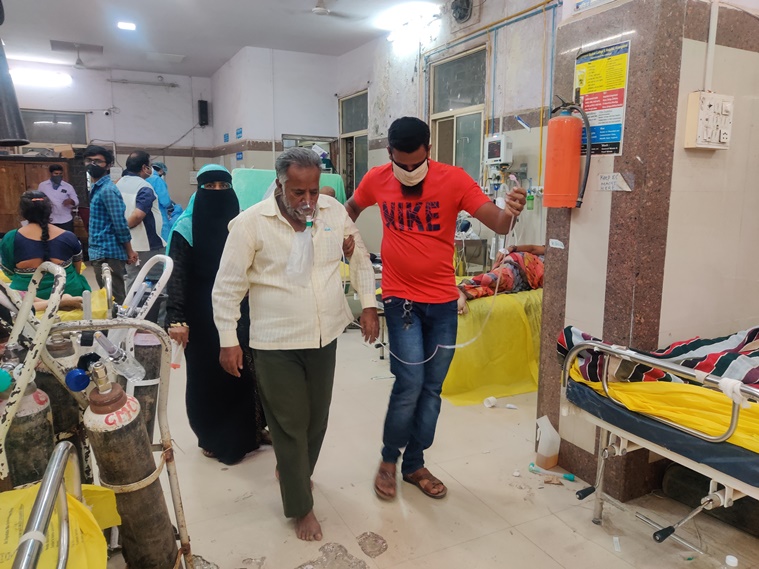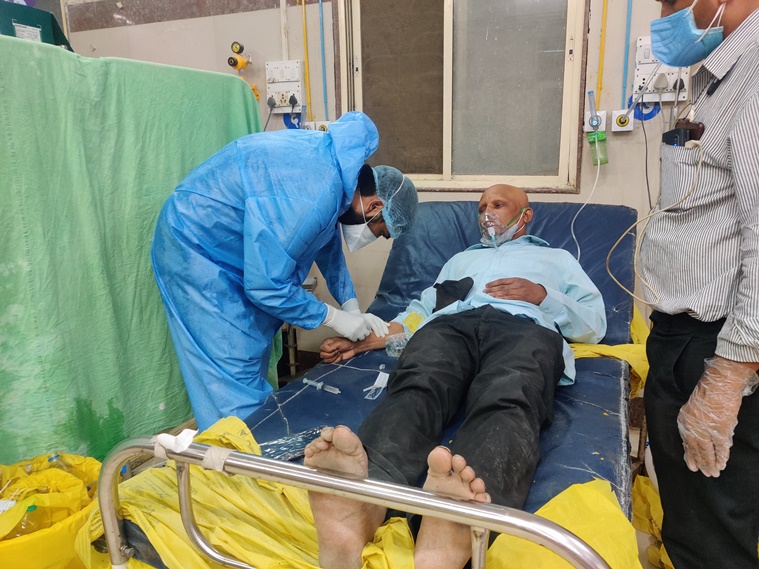
A severe shortage has skyrocketed the prices of oxygen cylinders across Maharashtra. Aurangabad, where positivity rates were the highest in the state at the end of March, is particularly hard hit, with all oxygenated beds occupied for the weekend and patients desperately seeking treatment at home.
The 2,214 oxygen beds were occupied during Friday and Saturday in the district, where the positivity rate was 43.8 percent in the last days of March. Out of a total of 15,484 active cases, 4,600 are in home isolation. Most are mild, doctors said, but some are moderately ill and require oxygen support.
Since March, the demand for medical oxygen has increased throughout Maharashtra. The current daily requirement for medical oxygen in the state is 700 to 750 metric tons, from 150 to 200 through the end of February. In Aurangabad, the daily requirement is 49.5 metric tons, up from 15-17 metric tons until the end of February.
There is no shortage of oxygen for patients admitted to hospitals, but hospitals are running out of oxygen beds. For patients who are turned away and advised home isolation, oxygen cylinders have become hard to come by.
Given the shortage, the state Department of Public Health ordered manufacturers last Tuesday to supply 80 percent oxygen for medical use and the rest 20 percent for industrial purposes through June 30.
 The cost of cylinders has also skyrocketed. The cost of refilling a 7,000 liter cylinder has more than doubled to Rs 350 from Rs 150. (Photo Express)
The cost of cylinders has also skyrocketed. The cost of refilling a 7,000 liter cylinder has more than doubled to Rs 350 from Rs 150. (Photo Express)
On Saturday, when Maharashtra tallied 49,447 cases, the highest since the pandemic hit the state last March, Chief Minister Uddhav Thackeray acknowledged the oxygen shortage and said the state was contemplating reserving full oxygen production at 100% for medical purposes for the next few days. days.
In Mumbai, new cases crossed the 9,000 mark for the first time, with 9,108 new cases. There were 277 deaths. On Friday, the figures for which are available, 3.28 lakh people were vaccinated, of which 57,390 were in Mumbai.
“Last week, we had decided to restrict the use of oxygen to 20 percent for industrial purposes and the remainder for the health system. Now, I feel like the time has come to use 100% oxygen for the health system. And even if that is not enough, we will be in a dire situation, ”Thackeray said in an interaction with reporters.
Muzammil Khan (40), a nurse at the GMC hospital in Aurangabad, tested positive in late March. A day later, his 90-year-old father Mustafa and his 40-year-old wife also tested positive. “We had mild symptoms, but my father’s oxygen saturation began to decrease. I’m a nurse, but I couldn’t find a hospital bed for her, ”Khan said.
A doctor recommended urgent oxygenation. Unable to get out due to isolation at home, Khan desperately called oxygen providers, NGOs and friends to obtain an oxygen cylinder. Only after three tense days, when his father’s oxygen saturation was hovering in the dangerous 70s, did a private hospital official who knew him well agree to lend him a cylinder.
 In Mumbai, new cases crossed the 9,000 mark for the first time, with 9,108 new cases. (Express photo)
In Mumbai, new cases crossed the 9,000 mark for the first time, with 9,108 new cases. (Express photo)
Shaikh Sattar, 51, a lab technician and diabetic, tested positive for Covid-19 on March 30. He soon developed a severe cold and cough. His oxygen saturation dropped to 86. “I went to three hospitals, none of them had spare cylinders. The oxygen beds have a waiting list, ”he said. Finally, on the doctor’s advice, he took favipiravir at home without oxygen support.
“A cylinder can only help one patient at home. In a hospital he can take care of several patients, ”explains oxygen supplier Abdul Hakim, owner of the Zainab oxygen company, which stopped supplying cylinders to homes for a week. Demand has quadrupled since March (from 200-250 to 800-900 cylinders a day) and Hakim cannot hold emergency stocks. “As demand has grown throughout Maharashtra, supply is lagging,” he said.
The cost of cylinders has also skyrocketed. The cost of refilling a 7,000 liter cylinder has more than doubled to Rs 350 from Rs 150. The upfront deposit for a cylinder at home is Rs 10,000, up from Rs 5,000.
Manish Mittal, owner of Sagar Gases, which supplies the best hospitals in Aurangabad, said manufacturers have raised the price of oxygen from Rs 10 per cubic meter to Rs 18. “The price increase is from the end of the manufacturer. Along with this, I need more drivers and workers to transport and handle more oxygen. If I have to deliver a cylinder especially to someone’s house, the additional transportation cost will be around 100 rupees, ”he said.
Mittal said the government has asked them to prioritize hospitals for oxygen supply, which will affect the household supply.
“The high cost of oxygen is still manageable, but the problem is the lack of availability of oxygen for treatment at home. If a patient does not have a hospital bed or cylinder at home, how will he be treated? “asks Masihuddin Siddique from the NGO Global Foundation who works with Aurangabad district officials to help patients with medication.
Pharmacist Kishore Waghmare said providers also require a prescription. in turn, doctors are reluctant to prescribe oxygen to patients in home isolation for fear of government action.
“For home treatment, a doctor must be willing to take full responsibility for the treatment. And not all private doctors are willing to do that, ”said Dr. Sundar Kulkarni, a civil surgeon from Aurangabad, denying that there was an oxygen crisis in the district.
The Aurangabad district has added 3,000 isolation beds for covid patients in the last month to bring the total to 20,084 beds. Of these, beds are available to moderate patients, but even for them, admission is granted only to those who do not have isolation facilities at home, authorities said.
At GMC, the largest government hospital in Aurangabad, there are 10 patients on the waiting list for Covid treatment. Dr. Kananbala Yelikar, Dean, GMC, was admitted to a Pune hospital for Covid-19 treatment during the week.
.